The day started out nice and sunny and a bit cooler than we
have been experiencing. (still quite warm, but comfortable) It’s a small
historic area and was an easy walk with plenty of stops to tour inside
churches, government and other historic buildings. It didn’t have the “southern
charm” that Savannah had, but was still a very interesting walk.
This town stinks! Seriously, the horse drawn carriage tours
are frequent and the smell of horse poo is pretty strong in areas.
We started at The Old Exchange & Provost Dungeon.
"By the 1770’s Charleston’s population was around 12,000 people, half of
whom were slaves. In one year, over 7,000 black Africans were channeled through
the city to other parts of the colonies. The Custom’s House (Exchange Building)
was where public slave auctions were held outside and along the adjacent
factors’ wharves. Other enterprises included brokers’ offices and a large
number of merchants who catered to the maritime trade. Rope, tar, lumber,
canvas and nails were kept in good supply."
We were given a tour of the Provost and then we self toured
the rest of the museum.
The Old Exchange Building
Provost Dungeon
the guide
model of the original building
Secret Powder Magazine storage was bricked up behind a wall
guide in the Great Hall
I signed the fake Declaration of the original 13 States
he demonstrated the various rifles & muskets used
demonstrating the bayonet
photo of George Washington
post office inside the Old Exchange
We continued on with the walk to The Old Slave Mart which is now a museum.
Chalmers Street
the Old Slave Mart
carriage tours
The Pink House is believed to be the second oldest
remaining structure in Charleston. It never was a house but was a tavern
and rumored to have housed a brothel in the upper floor.
The Douxsaint-Macauley House was erected by a French
Huguenot Paul Douxsaint in 1726. It's a fine example of early Federal period
homes with its beaded weatherboarding on the exterior, 9-over-9 windows, and a
roof with dormers. The pink neo-gothic French Huguenot (Protestant) Church
& graveyard.
9 over 9 windows
The Dock Street Theatre used to be a hotel before it was
turned into a theater and plays are still performed here. There were doing a sound check so we couldn't see the stage area.
inside the theater
It was lunch time so we headed to
the Brown Dog Deli, which had rave reviews. It was so good I had chowed down the whole sandwich before I remembered to take photos of our food. I had the Pig N' Fig - In-house pulled pork, fig-rosemary preserves, Granny Smith apples, applewood-smoked bacon and cheddar cheese on a panini-pressed local French baguette. (Apple Butter’s Big Brother!) and Greg had the Turkey in the Straw - Strawberries, creamy goat cheese strawberry-basil spread, red onions, *mesquite smoked turkey, applewood-smoked bacon and spinach topped with a balsamic reduction served on a toasted pita. YUM!
We continued on the tour where we left off.
French Huguenot Church
St. Phillips Episcopal Church . (the old wooden church was home to the oldest congregation in South Carolina what stands now was rebuilt when it burned down)
this cemetery was closed for renovation
Rev Thomas Frost buried here
The Old Powder Magazine is so old that when it was built
the word magazine had only one meaning and it was an arsenal of gunpowder from
1713 until 1748.
The Old Powder Magazine
The Circular Congregational Church is striking due to its
Romanesque style that stands out among the surrounding buildings. The graveyard
is the city’s oldest burial ground with monuments dating from 1695.
Visitor Center housed in a former Esso gas station
We walked through a small park to get to City Hall.
George Washington
City Hall
Post Office and Federal District Court Built in 1896
in the Renaissance Revival style, this attractive building is the federal
element on the Four Corners the of Law.
Post Office and Federal District Court
museum inside the working post office
early electric cancelling machine
the working postal windows
PO boxes
staircase to the court rooms upstairs
selling the traditional grass woven baskets & handicrafts
walking on Tradd Street which has at least 10 homes with landmark status
Rainbow Row is a series of row houses, painted in
bright colors, dating back to about 1740.
USS Yorktown in the distance
closer shot of USS Yorktown
Fort Sumter where the first shot was fired in the Civil War
Pineapple Water Fountain










































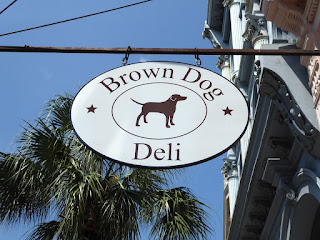












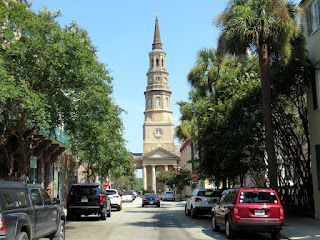



















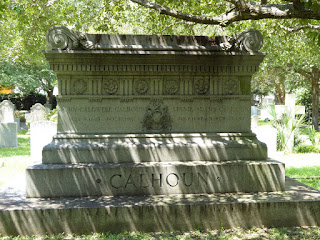


























































































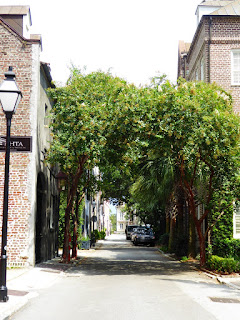




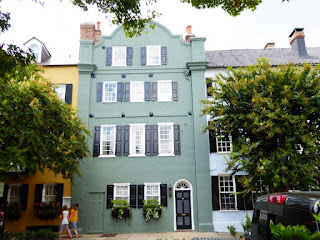
























No comments:
Post a Comment